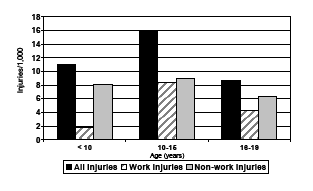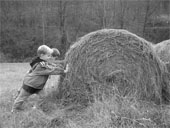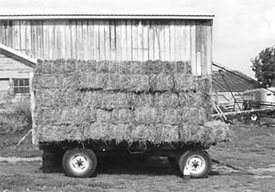| |
| Understanding how to create a safe farm environment is important for farm operators and their families. Youth who
live and work on farms are exposed to potentially dangerous farm-related hazards. |
Content
Youth on U.S. Farm Operations, 2006
- In 2006, 2.1 million farms were in operation in the U.S.
- There was an estimated 1.1 million youth living on these farms, 307,000 youth hired to work on
the farm, and 29.3 million youth who visited a farm.
- Over 25% (571,000) of farms reported having youth less than 20 years old living on them.
Youth Fatalities on U.S. Farms, 1995-2002
- In the 8-year period, 1995 through 2002, 907 youth died on farms (8.4 deaths/100,000 youth). 13% of these deaths were workrelated.
- Of the 907 youth who died on farms in the U.S., most were between the ages of 16 and 19 years.
- The majority of deaths to youth on U.S. farms were due to machinery (23%), motor vehicles (19%), and drowning (16%).
Youth Farm Injuries, 2006
- Results from the 2006 Childhood Agricultural Injury Survey (CAIS) estimated 22,900 injuries occurring to youth who lived on, worked on, or visited farms in 2006.
- Over 50% (11,700) of the injuries were to youth who lived on the farm.
- Over 10,000 of these injuries occurred to youth between the ages of 10 and 15 years.
- The most common types of injuries were fractures (27%) and cuts (21%).
- The body parts most commonly injured were the arm (19%), leg (16%), and hand, wrist, and finger (14%).
- Between 1998 to 2006, the injury rate for youth living on farms has decreased from 19.2 injuries/1,000 youth to 10.4 injuries/1,000 youth.
Non-fatal injury rates (per 1,000) for youth
living on U.S. farms by age group, 2006

In 2006, household youth between the ages of 10 and 15
years had the highest rate of injury.
How to Keep the Youth on Your Farm Safe
- Children do what they see...be a good role model for farm safety. Devote time to discuss FARM SAFETY with your
children.
- Inspect your farm for hazards. Remove as many hazards as possible. Mark dangerous areas clearly with hazard signs.
- Provide an enclosed and supervised safe play area for children. Do not allow children
to play around machinery, workshops, storage buildings, or where work is occurring on the farm.
- Assign farm chores to youth that are appropriate for their age such as those recommended in the North American Guidelines for Childhood Agricultural Tasks (NAGCAT).
- All entrances to ponds, lagoons, pools, and manure pits should be restricted. All farm ponds should have water safety and rescue equipment.
Keeping Youth Safe Around Animals
- Teach youth how to handle and work with animals safely.
- Farm animals that are breeding, have newborns, or are sick can be aggressive; make sure children have no contact with
these animals.
- Children should wear proper protective clothing when handling animals, such as closed toe, non-skid shoes.
- All household pets should have proper health checks and shots.
Keeping Youth Safe Around Machinery
- Do not allow extra riders on tractors, all terrain vehicles (ATVs) and other farm equipment; follow the “ONE SEAT— ONE RIDER” rule*.
- NEVER leave keys in the ignition of machinery or vehicles.
- Limit operation of ATVs, tractors, and machinery to older youth. The ATV institute recommends that youth less than 16 years only ride ATVs 90 cc or less. Youth should not operate any ATV without wearing a helmet.
- Child labor laws require that hired youth be at least 16 years old to operate tractors and machinery on farms, except for 14- and 15-year olds who have received operator certification. All youth should be properly trained before operating tractors or machinery.
- Child labor laws do not apply to youth on their family’s farm. The laws do help parents determine which farm tasks are especially hazardous. Youth between the ages of 10 and 15, a time period of high injury rates, are not old enough to do hazardous work safely.
- Youth, like adults, should not operate farm tractors without a Roll-Over Protective Structure (ROPS) and a seatbelt.
- Youth should not operate tractors or other vehicles on public roads without a driver’s license.
* Training seats are designated for training purposes only.
Farm Youth Dies Hitching A Hay Wagon
2004 — A 12-year-old died while hitching
a hay wagon to a flatbed truck. As the youth lifted the tongue of the wagon, it began to roll toward the truck. The youth failed to get the tongue hitched, and the boy’s head was crushed between the wagon and the truck’s bed. |
|
Keeping Youth Safe from Falls
- Provide an enclosed and supervised safe play area away from hay lofts and machinery.
- Place a shock absorbing ground cover, such as sand, mulch, or wood chips, under all elevated play equipment.
- Youth should wear proper riding helmets when riding horses.
- All fixed ladders on grain bins and silos should be equipped with locks.
- Inspect your farm regularly. Provide adequate lighting and make sure floors are properly cleaned.
- Instruct youth on the “three-point system,” meaning that three of your four limbs are in contact with the ladder or vehicle at all times, either one hand and two feet, or two hands and one foot.
- All hay and grain chutes and openings should be securely covered when not in use.
Farm operators who hire youth to work on their farm should be aware of all applicable child labor laws. |
For More Information
National Children’s Center for Rural and Agricultural Health and Safety
1000 North Oak Avenue
Marshfield, Wisconsin 54449
Telephone: 1-888-924-SAFE (7233)
Web: www.marshfieldclinic.org/nfmc
North American Guidelines for Children’s Agricultural Tasks (NAGCAT)
Telephone: 1-888-924-SAFE (7233)
Web: www.nagcat.org
Farm Safety 4 Just Kids
11304 Aurora Avenue
Urbandale, Iowa 50322
Telephone: 1-800-423-5437; 515-331-6506
Web: www.fs4jk.org
U.S. Department of Labor
Frances Perkins Building
200 Constitution Avenue, NW
Washington, DC 20210
Telephone: 1-866-4-USA-DOL
Web: www.dol.gov/dol/topic/youthlabor/Agriculturalemployment.htm
Childhood Agricultural Safety Network
Web: www.childagsafety.org
American Association of Poison Control Centers
Telephone: 1-800-222-1222
Web: www.aapcc.org
To receive NIOSH documents or for more information about occupational safety and health
topics, contact:
1-800-CDC-INFO (1-800-232-4636)
1-888-232-6348 (TTY)
E-mail: cdcinfo@cdc.gov
Visit the NIOSH Web site at: http://www.cdc.gov/niosh
Visit the NIOSH Childhood Agricultural Injury Initiative site at:
http://www.cdc.gov/niosh/childag/
Safer · Healthier · People™
DHHS (NIOSH) Publication Number 2009-117
February 2009
Centers for Disease Control and Prevention
National Institute for Occupational Safety and Health
|
| 
 This document is also available in PDF format. This document is also available in PDF format.
2009-117.pdf
(2 pages, 439 KB)

|
|


